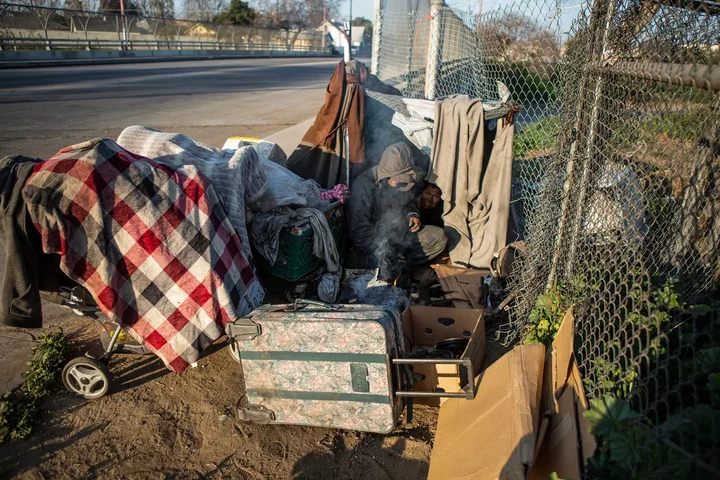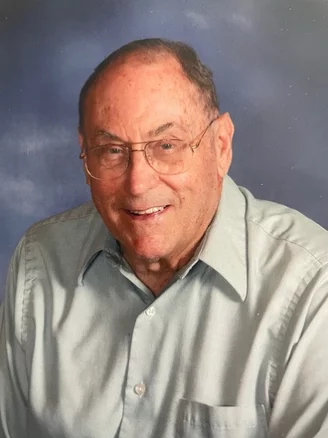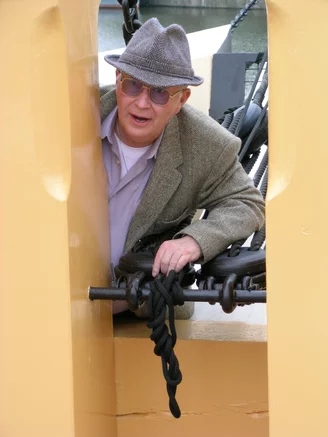The Biggest Survey of Homeless Californians in Decades Shows Why So Many Are on the Streets
Marisa Kendall / Tuesday, June 20, 2023 @ 7:26 a.m. / Sacramento
A man starts a fire while his wife sleeps inside their makeshift tent along a barbed wire fence near Highway 99 in southwest Fresno on Feb. 11, 2022. Photo by Larry Valenzuela for CalMatters/CatchLight Local.
Losing income is the No. 1 reason Californians end up homeless – and the vast majority of them say a subsidy of as little as $300 a month could have kept them off the streets.
That’s according to a new study out of UC San Francisco that provides the most comprehensive look yet at California’s homeless crisis.
In the six months prior to becoming homeless, the Californians surveyed were making a median income of just $960 a month. The median rent for a two-bedroom apartment in California is nearly three times that, according to Zillow. And though survey participants listed a myriad of reasons why they lost their homes, more people cited a loss of, or reduction in, income than anything else.
The study’s authors say the findings highlight the idea that money, more than addiction, mental health, poor decisions or other factors, is the main cause of – and potential solution to – homelessness.
“I think it’s really important to note how desperately poor people are, and how much it is their poverty and the high housing costs that are leading to this crisis,” said Margot Kushel, a physician who directs the UCSF Benioff Homelessness and Housing Initiative, which conducted the study.
Already the study – which the authors say is the most representative homelessness survey conducted in the U.S. since the mid-1990s – has drawn attention from high places.
The initial idea for the survey came from California Health and Human Services Secretary Mark Ghaly, Kushel said. Ghaly’s office has been involved along the way, though the state didn’t fund the research.
“As we drive toward addressing the health and housing needs of Californian’s experiencing homelessness, this study reinforces the importance of comprehensive and integrated supports,” Ghaly said in a news release. “California is taking bold steps to address unmet needs for physical and behavioral health services, to create a range of housing options that are safe and stable, and to meet people where they are at. We are grateful for the voices of those who participated in this study, as they will help guide our approach.”
The survey comes as local governments press Gov. Gavin Newsom to distribute ongoing funding to fight homelessness, arguing the one-time grants he has doled out so far don’t allow them to make lasting progress. Newsom has resisted that kind of multi-year commitment, although his administration has allocated nearly $21 billion toward homelessness and housing since he took office.
The UCSF team surveyed 3,198 unhoused adults throughout California between October 2021 and November 2022, and conducted in-depth interviews with 365 of those participants.
What drives California’s homeless crisis?
When asked why they left their last home, respondents cited conflict between roommates, not wanting to impose on the person or people they were living with, domestic violence, illness and breakups.
A loss of or reduction in income was the most common response, with 12% of people saying that’s what caused their homelessness. Just 4% blamed their own substance use or drinking.
All of those varied factors that led people to lose their homes often have underlying roots in economic instability, said Jennifer Wolch, a professor emerita at UC Berkeley specializing in homelessness.
“This lack of income and severe instability and housing precarity, it has spillover effects on people’s relationships, their use of alcohol and other kinds of problematic substances,” she said. “It impinges on their health status.”
The story told by one survey participant, identified as Carlos, shows how someone can gradually descend into homelessness. He had to stop working after falling off a ladder and injuring his spine, but wasn’t eligible for workers’ compensation because he had been paid in cash. Unable to afford his rent, he moved out of his apartment and rented a room in a new place. He soon left due to conflicts with his roommates. He then briefly lived with his sister’s family, until they faced COVID-related job loss and he moved out to avoid becoming a burden. He lived in his truck until it was towed due to unpaid parking tickets. Now, he lives in an encampment in a park.
Most of the homeless Californians surveyed said a relatively small amount of cash would have saved them from the street. Seventy percent said a monthly rental subsidy of $300-$500 would have kept them from becoming homeless, while 82% believed a one-time payment of between $5,000 and $10,000 would have worked.
Jennifer Loving, CEO of Santa Clara County nonprofit Destination: Home, hopes the study’s findings will help debunk what she says is a common myth that people are homeless because of their individual failings, rather than because rents are outpacing wages. She’d like to see California’s leaders take notice.
“Hopefully it will inform a statewide strategy,” she said, “because we need a statewide strategy to be able to manage how we are addressing homelessness.”
Another California homeless myth
Another myth the study attempts to dispel is that most homeless people flock to California cities because of warm weather, liberal policies and generous services. In reality, 90% of the people surveyed said they were last housed in California, and 75% live in the same county as where they lost their housing.
That’s important to remember, Wolch said, because it’s easy to disregard unhoused people who we think “aren’t from here” and haven’t paid taxes here.
“People who are homeless are your neighbors,” she said. “People who are homeless live in the same city that you do and they possibly have lived there longer than you have.”
The survey painted a bleak picture of the traumas and tragedies that made survey participants more vulnerable to ending up on the street. People reported growing up in depressed communities with few job opportunities, where they experienced exploitation and discrimination. Nearly three-quarters said they had experienced physical violence during their lives, and one-quarter had experienced sexual violence.
One in three people surveyed attempted suicide at some point.
Mental health and addiction also were a common undercurrent in the lives of many of the unhoused people surveyed, which is to be expected in a population that has suffered so much trauma, according to the researchers. Two-thirds of people reported experiencing mental health symptoms – including depression, anxiety or hallucinations – in the past 30 days. Homelessness and all it entails, including lack of sleep, violence and difficulty accessing medication, exacerbated their symptoms, many people said.
About one-third of people reported using drugs three or more times a week – mostly methamphetamines. And 1 in 5 people who reported regular drug or heavy alcohol use said they wanted addiction treatment but couldn’t get it.
Jail to homelessness pipeline
The study also emphasizes the relationship between incarceration and homelessness, said Alex Visotzky, senior California Policy Fellow for the National Alliance to End Homelessness.
More than three-quarters of people surveyed had been incarcerated at some point during their life. And in the six months before becoming homeless, 43% were in jail or prison, or were on probation or parole. The vast majority of those who had been incarcerated received no help signing up for housing, healthcare or benefits upon release.
“That drove home for me this point: Incarceration, homelessness and then subsequent criminalization are fueling a really vicious cycle for marginalized people, especially Black and Latino Californians, that’s both causing and prolonging homelessness,” Visotzky said.
‘We don’t have enough housing for poor folks’
To solve the homelessness crisis, the main problem California needs to address is the lack of housing that’s affordable for extremely low-income residents, according to the researchers. The state has just 24 affordable and available homes for every 100 extremely low-income households, according to the National Low Income Housing Coalition.
Among the solutions the researchers proposed: expanding vouchers that use federal, state and local dollars to subsidize people’s rent. They also suggested piloting shared housing programs where multiple households live together and split costs, while also providing funds to help people remain with or move in with family or friends.
Kushel hopes the study helps drive public support for these ideas, which in turn will spur politicians to act.
“I hope that it really focuses our efforts on housing, which is the only way out of homelessness,” Kushel said. “It’s almost so obvious it’s hard to speak about. We don’t have enough housing for poor folks.”
###
CalMatters.org is a nonprofit, nonpartisan media venture explaining California policies and politics.
BOOKED
Today: 12 felonies, 20 misdemeanors, 0 infractions
JUDGED
Humboldt County Superior Court Calendar: Friday, Jan. 9
CHP REPORTS
2542 Quinlan Ave (HM office): Traffic Hazard
Sr255 / V St (HM office): Live or Dead Animal
ELSEWHERE
Washington Post: A woman’s life among black bears taught her a lot about being human
Washington Post: Trump’s college agenda may have a lasting impact on research, culture
AP News: Iran warns against US strikes as activists say protest death toll reaches 203
The Atlantic: The Most Shouted-At Politician in America
How Fresh Will CalFresh Be? Food Benefits on the Table in State Budget Talks
Rya Jetha / Tuesday, June 20, 2023 @ 7:13 a.m. / Sacramento
A customer picks produce at the Fairfield Farmers’ Market on June 15, 2023. Photo by Semantha Norris, CalMatters.
Every Thursday at the Fairfield Farmers’ Market, many customers don’t pay for their fruits and vegetables with cash, credit card or Apple Pay. Instead, they go to the information booth, swipe their CalFresh EBT card and receive paper vouchers to spend on produce.
Under Market Match, California food aid recipients get as much as $10 in matching money — meaning they have at least $20 to spend every week at their local farmers’ market.
“We already spend $200 on meat and cheese at Costco,” said Mitzi Castillo, who lives in Fairfield with two young daughters. “If I didn’t have Market Match, they would have to wait ’til next week to eat fruits and veggies when my husband gets paid.”
Castillo buys cherries, strawberries and blueberries from one of the many farmers who also reap benefits from the program, which brings customers and more cash to more than 270 farmers’ markets across the state.
“For me, I get more money, and for the people who use it, they can feed their family more,” said Salvador Navarro, a farmer from Stockton who said he makes as much as $300 from Market Match at the Fairfield Farmers’ Market, more than enough to cover the cost of his stall.
Together with his stalls across the Bay Area, Navarro says he makes $50,000, or a fourth of his income every season, from CalFresh customers and Market Match.
Market Match is the largest funding beneficiary of the California Nutrition Incentive Program, which is run by the California Department of Food and Agriculture. In 2022, the program provided about 38 million servings of fruits and vegetables to CalFresh participants, accounting for $19.5 million in CalFresh and Market Match spending at farmers’ markets across the state.
However, like many initiatives, the fates of Market Match and other healthy food and nutrition programs are in flux as legislative leaders and Gov. Gavin Newsom negotiate the final state budget while tackling a $31.5 billion deficit.
Although the plan that legislative Democrats pushed through on Thursday includes $35 million for the incentive program, advocates, CalFresh recipients and farmers worry that the money won’t be in the final budget.
“What we’re doing now is trying to get the ear of the governor,” said Minni Forman, the director of Market Match, which also includes community groups coordinated by the nonprofit Ecology Center. If the program is not funded in the final budget, Forman says the program will return to fundraising in the philanthropic world, which could mean a major reduction and even the end to Market Match.
“I’m worried, and I’m fighting as hard as they are to make sure that it is (part of the final budget),” Assembly Budget Committee Chairperson Phil Ting told CalMatters.
The San Francisco Democrat authored the 2015 law creating the incentive program that now funds Market Match and also championed additional funding in 2018.
Ting declined to comment on the status of ongoing negotiations between legislative leaders and the Newsom administration, as did Senate Budget Chairperson Nancy Skinner, an Oakland Democrat.
Sen. Melissa Hurtado, a Bakersfield Democrat, emphasized the importance of the $35 million for the nutrition incentive program, calling it a “priority” and highlighting her bill to make it official state policy for everyone to have access to enough healthy food.
Keeping Market Match funded is also a priority for farmers across California promoting the #FundCNIP campaign. They include Jeff Nielsen, an organic avocado farmer who manages Cambria Farmers Market and three other markets. He says that because of the program, people who don’t traditionally go to farmers’ markets find foods they like and keep coming back.
“They’ll get $10, $20, even $30 (in produce) from the market, which is a really big win,” said Nielsen. “For every local that comes every week, it supports them, the farmers, and the community.”

Farmer Salvador Navarro and his daughter Kimberly at the Fairfield Farmers’ Market on June 15, 2023. Most of Navarro’s customers use Market Match and other benefit programs to buy their produce. Photo by Semantha Norris, CalMatters.
The worries about the possible demise of Market Match and other healthy food incentive programs are growing amid broader concerns that California faces a “catastrophic hunger crisis” as pandemic-era extra CalFresh benefits come to an end. Even with those additional benefits, 20% of Californians experienced food insecurity in 2021. This year, the number is expected to rise rapidly.
Last week, U.S. Health and Human Services Secretary Xavier Becerra visited Sacramento to address food insecurity and nutrition inequities.
“I know the governor has been moving in ways to try to address those social needs, including food insecurity for so many Californians,” Becerra, a former state attorney general and member of Congress, said at a press conference. “I don’t believe that my state, which I’m very proud of, is going to abandon the effort to try to keep people moving in the right direction, and that of course, has to include healthy foods.”
Where food aid stands in budget
So far, the Legislature has approved the governor’s more modest anti-hunger proposals, including the creation of a summer program for eligible households to receive $40 per month in food assistance benefits for each child, a substantial drop from the $125 per month for each child that families received last summer. Lawmakers have also approved the expansion of California’s food assistance program for undocumented immigrants 55 and older, beginning in late 2025.
Overall, the governor’s May budget proposal included a total of $2.7 billion in state and federal funding for anti-hunger programs. However, the Legislature’s budget includes a variety of food benefits that the governor did not include:
- $35 million for the incentive program that funds Market Match and a handful of other incentive programs;
- $30 million for a CalFresh $50 minimum benefit pilot program;
- $9.9 million for a broader California Fruit & Vegetable EBT pilot program;
- $3 million to extend a CalFresh program to buy safe drinking water.
The original proposal to increase the minimum CalFresh benefit from $23 to $50 per month statewide was estimated to cost $95 million. However, the Legislature’s budget deal includes only $30 million, enough for a pilot program in some counties. As budget negotiations continue, there is some doubt that even the reduced $30 million will make it.
“I recognize with the budget deficit that it’s going to be hard to include,” Sen. Caroline Menjivar, a Van Nuys Democrat who authored the minimum benefit bill, told CalMatters in a recent interview. “But the impact is so big, should this pass and get funding.”
While Market Match focuses on farmers markets and uses vouchers and tokens, the California Fruit & Vegetable EBT Pilot Project borrows a model pioneered by Massachusetts to promote nutritious shopping at grocery stores.
Eli Zigas, the food and agriculture policy director at SPUR, a nonprofit policy research institute, says that CalFresh recipients predominantly shop at big-box stores and supermarkets. The test program allows recipients to get money rebated directly back on their EBT cards after buying fruits and vegetables at authorized grocery stores.
The pilot plans to have more than 80 locations running by the end of the summer, but Zigas worries that the final budget may delay efforts to make the program statewide and permanent. Last year, when the state had a record budget surplus, the program received $120 million. This year, supporters asked for $94 million over two years, but received $9.9 million in the Legislature’s budget.

A customer picks produce at the Fairfield Farmers’ Market on June 15, 2023. Photo by Semantha Norris, CalMatters
Back at the Fairfield Farmers’ Market last week, 82-year-old Gurdial Singh walked from stand to stand, using his Market Match vouchers to buy vegetables. “My wife and I will cook dinner together tonight with the zucchini, eggplant and cucumbers,” he said. “We enjoy this program very much as senior citizens.”
Luis Nava, a market manager with the Pacific Coast Farmers’ Market Association who staffs the Fairfield Farmers’ Market, said he wants to send a message to the governor:“We need this program to help low-income families, and if it goes away, it will take away food from our kids’ tables. We need it. We really, really need it.”
###
CalMatters.org is a nonprofit, nonpartisan media venture explaining California policies and politics.
OBITUARY: Venus-Victoria Lucero-Marina Torrez-Hamilton, 1974-2023
LoCO Staff / Tuesday, June 20, 2023 @ 6:56 a.m. / Obits
Venus-Victoria
Lucero-Marina Torrez-Hamilton, born on December 4, 1974, tragically
and unexpectedly departed from this earthly realm to join the spirit
world on Monday, May 1, 2023. She passed away due to a sudden stroke
in her new home near Hydesville.
Venus is survived by her beloved father, Daniel Torrez; mother, Maureen Exworthy; five brothers; seven sisters; and her three cherished children, Anthony Reyes, Marissa and Andrew Castro, who held a special place in her heart. Additionally, she leaves behind her first granddaughter, Eliza Lynn, as well as her long-time companion dog, Talullah.
Venus first graced this world in Ixpalino, a small town in Sinaloa, Mexico, and spent her formative years growing up in Santa Cruz. Throughout her life, she embarked on various journeys, including many visits back to Mexico, and she lovingly raised her children in San Jose, before ultimately finding solace and settling down in Humboldt County.
An ardent lover of all creatures and being outside in nature, Venus relished in embracing life to its utmost potential. She possessed an unwavering passion for art, fashion, DIY projects, and crafts, which truly ignited her spirit. All who knew her knew she was also a lover of unicorns. Venus was not only a loyal friend but also a devoted aunt to her nieces and nephews, nurturing their growth and happiness.
Venus’s profound existence touched the lives of countless others as she traversed her extraordinary path. In remembrance of her remarkable journey, a celebration of life memorial will be held on June 24 at 1 p.m. at the Healy Center in Redway. This gathering will serve as a testament to the impact she made on the lives of those fortunate enough to have known her. May Venus’s soul find eternal peace, and may her memory forever resonate within our hearts, reminding us of the joy, love, and inspiration she shared with us during her time on this earth.
###
The obituary above was submitted on behalf of Venus’ loved ones. The Lost Coast Outpost runs obituaries of Humboldt County residents at no charge. See guidelines here. Email news@lostcoastoutpost.com.
OBITUARY: Eugene E. Steele Sr., 1954-2023
LoCO Staff / Tuesday, June 20, 2023 @ 6:56 a.m. / Obits
It is with a sad and heavy heart we announce the passing of a great
man, Eugene
E. Steele Sr. (A.K.A. Gene), on June 7, 2023 at the age of 69 years
young.
Born May 18, 1954 to Harold Steele and Jane McGilvra in Eureka, Eugene was a lifelong resident of Humboldt County for the last 45 years. At age 17 he enlisted in the US Army and became a private first class sergeant. After the Army he joined the Eureka National Guard.
Some of his favorite passions were truck driving, working on and fixing cars, hunting with family, fishing when he got the chance, camping, riding his horse Cherrypicker, working in the summer on his Uncle Dan’s farm in Washington and pending time with his family, grandkids, good friends and cousins who lived close by or talking on the phone for hours, catching up on what has been going on in their lives.
Eugene is preceded in death by his parents Harold (Willadean Steele) and Jane McGilvra (Lou Barnette); Aunt Betty Lima, Donald and Leona Steele, LaVern Steele Sr and many others — brother Les (Rose Steele) grandparents Viola Steele (Roy) brother-in-laws Robert J McLaughlin, Mike Hensley, two daughters Melinda Steele-Charest, Kandie Charest; step-sister Kathy Holt-Card, step-brothers Vern and Leon Moss. Aunt-in-law Linda Lange. Mother-in-Law Nancy Charest. Grandparent-in-laws Fred and Lula Lange.
Eugene is Survived by his Loving wife of 34 years Michelle L Steele. His children: Eugene Steele Jr, (Ashley McCurdy) Justin Steele (Arie) Crystal Steele- Reeves (Mike) Jeanie Kay Steele. Grandkids: Mylee, Bentley, Mallory, Raylin, Jocelyn, Cameron, Milo Steele, Miranda. Cheyenne, Tasha, T.J. Marshall, Codey and Devon Steele. Great-grandkids Michael and Pamela Steele. Other family members include favorite cousins Laverne Steele Jr. Kenny, Donny, Ronald, Mike Brenda Steele, Kim Lima-Smith, Steve Steele. Other family members include brothers Gary (Marla) and family, Hal, Randy, Jim Steele and sister Marjorie Steele and their families. Extended family includes: Arthur Lange Terry Lange (Betty) Diane Morgan, Alicia Morgan, James Holdner, Pauline McLaughlin, Jerry Hensley, Jason Coffee, Adamay, Robert, Grace Titus and Family, Cody Hensley and Family, Ladonna Brown and family. Marilyn Linder-Moss and family. Danny and Sherry Moss and Family, Michelle Barns and family and to many more to numerous to mention. Our families were very large and wide spread all over the United States. Favorite friends also included Larry Christensen, Wayne Johnson, Gene Stiles, Rich Grow, Eddie Mendoza, Kid and Maryann Thompson, Mike Astry, Norman and Gail Foust, Kim and Sarah Elder, Ron Millsaps and his family, just to name a few.
Please join us for a potluck Celebration of Life on Saturday July 22, 2023 at 1 p.m. at 1611 Manila Drive, Manila. It’s the old school, some call it, and others call it the Manila Community Center. It’s on the ocean side of the freeway coming from Arcata. All friends and family are welcome to come share a story and enjoy some food.
###
The obituary above was submitted on behalf of Eugene Steele’s loved ones. The Lost Coast Outpost runs obituaries of Humboldt County residents at no charge. See guidelines here. Email news@lostcoastoutpost.com.
OBITUARY: Ralph M. Nelson, 1928-2023
LoCO Staff / Tuesday, June 20, 2023 @ 6:56 a.m. / Obits
Ralph was born in
Wilmar, California. In his life time he watched our country grow and
change. While growing up he lived on a horse ranch until he graduated
from El Monte High School.
Shortly thereafter, tailing-ending World War II, he joined the Army Air Corps as a a high-speed radio operator. The GI Bill helped pay his Woodbury College tuition. He majored in advertising. As a print production manager in advertising in the Los Angeles offices for 33 years he worked for several national and international advertising agencies before he retired and moved to Eureka.
He met the love of his life, Emma, in Pasadena, married in 1955. On Mothers Day this past May 2023, Ralph joined his love in Heaven. He was survived by two children, six grandchildren and nine great grandchildren.
Ralph was a hiker, gardener and writer.
He was actively involved in Eureka during his retirement years. He enjoyed musical theater. He was in six productions and attended many of Humboldt Light Operas performances. He was also a part of Rotary with memories of the Festival on the Bay.
Writing, he was part of the Silver Quills, where he has a few published short stories. He took many long walks in the local area. He was a longtime member of First United Methodist Church Eureka. Retirement kept him busy. Living in Eureka provided a great back drop for his hobbies. Landscaping his yard was his joy as countless hours of love went into each plant planted and each weed pulled (blackberries tried to take over).
Sports can’t be ignored, as we rooted for the Dodgers for many years until retirement. Moving to Eureka he gave up his love for the Dodgers and started routing for the Giants. Well, guess if you can’t beat them, you join them.
Ralph had a long, wonderful life full of memories that are shared with many family and friends. His sense a humor that would have you in laughter often. Ralph’s strongest trait was the graciousness in which he treated everyone with respect and kindness.
A special public thank you to his special lady friend Minerva, who joined him on many actives at the Senior Center, long walks and daily evening talks since the passing of his wife Emma.
His celebration of life will be held at First United Methodist Church in Eureka, CA 520 Del Norte, Eureka, CA on June 24, 2023 at 2 p.m.
###
The obituary above was submitted on behalf of Ralph Nelson’s loved ones. The Lost Coast Outpost runs obituaries of Humboldt County residents at no charge. See guidelines here. Email news@lostcoastoutpost.com.
OBITUARY: Charles Edward Winfrey, 1943-2023
LoCO Staff / Tuesday, June 20, 2023 @ 6:45 a.m. / Obits
Rev.
Charles Edward Winfrey passed away in his home on June 10, 2023, with
his son by his side.
Charles was born on August 24, 1943 in Lebanon Missouri to Rev James Winfrey and Oma Winfrey Sommerhause. His father died before his fourth birthday. A few years later his mother moved her family to California where she remarried in 1950. In 1955 the family moved from San Diego to Eureka. He graduated from Eureka High in 1962 then worked for Purity Grocery Store, where he would meet his future wife, Kathy, whom he married at then First Congregation Church in Eureka in September of 1965. The following month the army sent him to Okinawa. In 1967 after being discharged from the army he returned back to Eureka to his wife and then began working for Humboldt Bay Pacific Gas & Electric Company until he retired in 2009 after 42 years.
Charles was devoted to his wife of 40 years until her death in 2005 and continued to miss her to the end. Family and his faith were the most important aspects of his life. He pursued all activities that his children were involved in, being seen at various sporting games, music concerts and fund raising events, to becoming involved as a little league umpire to being involved when his son got involved with racing cars. Anything his children were involved in he gave his full support and encouragement. He enjoyed a passion for history, with his main focus on the American Civil War. He got pleasure from his rose garden, ship models and his involvement with the Humboldt County Volunteer Sheriff Posse in the 1970s. He also enjoyed his trips to England to visit his daughter, son-in-law and granddaughter.
Charles enjoyed eating out at restaurants around area. He was even known to travel to Sepastapol to have a meal. He was well known around the local establishments and most people knew him by name when he walked in. One of the things he liked and enjoyed doing while eating out was picking up the bill of an unexpected diner. Sometimes they would know that he paid for their meal and sometimes they never knew who the act of kindness was from. This gave him great joy as he was able to give something back to others.
Charles was very active within the local Baptist church community, serving as a deacon and associate pastor at Myrtle Avenue Baptist Church (Harvest Church), Sunny Brae Baptist Church, Trinity Baptist Church and Calvary Baptist Church. He filled in as interim pastor at various churches and traveled to Bridgeville, Rio Dell, Klamath and Hoopa preaching and ministering to others and sharing the word of God to others, which gave him great pleasure. He had a great ability to talk to people and put them at ease. He had a genuine interest and a caring nature for those around him. He was always trusting in people and was willing to give everyone a chance. His faith remained strong right up to the end. He has entered eternal rest and has been reunited with his beloved wife and family that have gone before him.
Charles is preceded in death by his wife, Kathy Winfrey; parents; James Winfrey, Oma Winfrey Sommerhause; stepfather, Ralph Sommerhause; father-in-law, Richard Tausch; mother-in-law, Barbara Tauschl; sister, Ruth Street; brother-in-law Dan Street; brother, James Winfrey; sister, Diane Bent; brother-in-law Patrick Bent; and nephew Dan Street.
Charles is survived by his daughter, Heidi (Luke) Hollingbery; son, Jacob (Jeannie) Winfrey; granddaughter, MaKayla Hollingbery; step-grandson Chris (Gabby) Borges; step-grandson Daniel Kirkpatrick; nieces and nephews Debi (Jim) White, David (Lisbet) Street, James (Dana) Winfrey, Kathy Street, Chelsea Brown, Courtney (Mark) Albritton, Kylie Bent; and many numerous great-nieces and -nephews and great-great-nieces and -nephews.
You are invited to join us on Saturday, June 24, at Calvary Baptist Church 3400 F Street, Eureka.
11 a.m.-1 p.m. viewing at Calvary Baptist Church
2 p.m. Funeral Service at Calvary Baptist Church
Followed by a potluck at Calvary Baptist Church. Please bring a dish for the potluck. We look forward to seeing you as we remember and rejoice in Charles’s life while hearing and sharing any stories or memories that you have of him as we have we can share with you. Like the time he fell off Satan.
The family wishes to thank Dr. Allen S Matthew MD and his team for all the care provided to Charles over the last few years to you we will always be indebted to.
Flowers can be sent to Sanders Funeral Home 1835 E Street Eureka, CA 95501 as funeral arrangements are through them.
###
The obituary above was submitted on behalf of Charles Winfrey loved ones. The Lost Coast Outpost runs obituaries of Humboldt County residents at no charge. See guidelines here. Email news@lostcoastoutpost.com.
GROWING OLD UNGRACEFULLY: UFOs — They’re Back!
Barry Evans / Sunday, June 18, 2023 @ 7 a.m. / Growing Old Ungracefully
The latest contender in the unending lineage of UFO whistleblowers is Air Force veteran and former intelligence officer David Grusch. His credentials are impressive: 14 years as a US intelligence officer, representative to the Unidentified Aerial Phenomena Task Force from 2019-2021, and, more recently, National Geospatial-Intelligence Agency’s co-lead for UAP (Unidentified Anomalous Phenomena) analysis. He resigned from the government last April “to advance government accountability through public awareness.”
The long line of UFO/UAP promoters arguably goes back to private pilot Kenneth Arnold and his report of nine “flying discs” flying past Mount Rainier in June 1947. (The discs morphed into saucers when newspapers picked up the story.) Since then, we’ve been regaled with tale upon tale of alien spacecraft buzzing/crashing on our planet. Roswell…crop circles…the Phoenix lights…New Jersey Turnpike phenomena…USS Nimitz encounter… David Fravor’s 2004 GOFAST video…Bob Lazar. (Remember him? MIT-educated physicist, Navy technician, worked at Area 51, witness to nine recovered flying saucers and alien cadavers. All lies, of course. He didn’t graduate at MIT, wasn’t a Navy tech, isn’t a physicist, had no connection with Area 51.)
Back to David Grusch. In a recent interview with the tech website The Debrief, he claimed that the government has secretly been collecting partial fragments of UFO “through and up to intact vehicles” for decades. Analysis showed the objects to be “of exotic origin (non-human intelligence, whether extraterrestrial or unknown origin) based on the vehicle morphologies and material science testing and the possession of unique atomic arrangements and radiological signatures.” In a later interview, he clarified, kinda: “…isotopic ratios…strange, heavy—high up in the atomic table—a very strange mix of elements.” Which sounds like the vague gobbledygook we’ve been hearing from the UFO community for years—just enough to sound like “real science” but not sufficiently specific to actually determine if the objects are truly exotic.
Major Jesse A. Marcel holding foil debris from a Mylar weather balloon (AKA crashed alien spacecraft) from Roswell, New Mexico, 07/08/1947. Public domain via Wikimedia.
But wait, there’s more: Aliens! For reasons best known to himself, in the original interview, Grusch kept the Real Story to himself. In a later one, he mentioned, as if in passing, “…when you recover something that’s either landed or crashed, sometimes you encounter dead pilots…it’s true.” (Why are we analyzing bits of exotic metal when we’ve got bits of actual aliens?)
This would all sound a tad more convincing if Grusch was claiming first-hand knowledge of the aliens and their crash-prone vehicles. But no, his claims are all based on “extensive interviews with high-level intelligence officials.” This is where my spidey-sense gets into high gear. Here’s a guy with top-secret clearance, 14 years in the US intelligence community, years of analyzing reports of unidentified aerial phenomena…who didn’t bother to check for himself!
What’s with that? Fear of flying? (He served in Afghanistan, so unlikely.) Gullible or incurious to the point of idiocy? Afraid he’d discover that the stories he was told were all confabulated, meaning he’d be out of a job? The better to advance a future career on the lecture circuit? Pardon my cynicism, but you’ve got wonder why he didn’t take a day out of his busy DC life to fly to Nevada and see for himself. Aliens were his life, his career, the reason he went into the office every day…and he couldn’t be bothered to see the evidence for himself, instead of relying on hearsay???
Military intelligence: the best example of an oxymoron.








